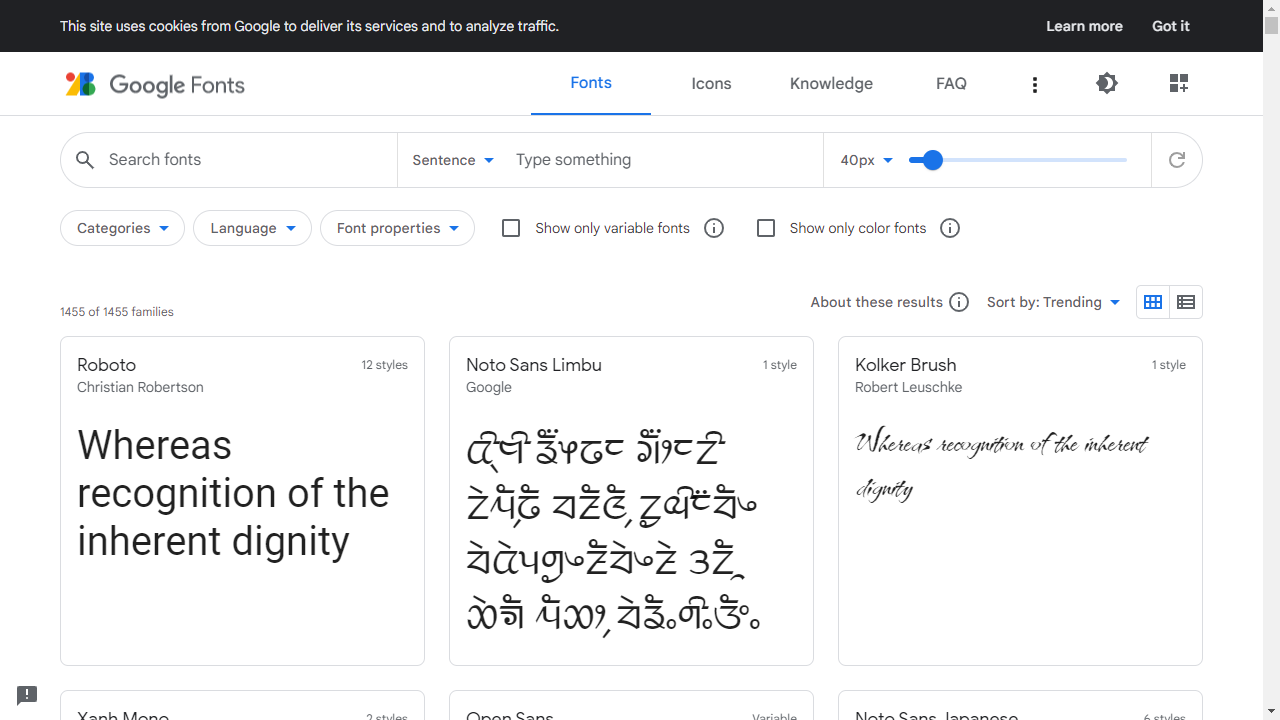SEO Tips for E-commerce: Improve Your Online Shop's Ranking in Google
SEO is an important tool for e-commerce businesses to bring in new customers. Here are the best tips for your online shop to rank higher in Google.

Google Fonts is one of the many free and easy-to-use tools Google provides to website operators. When using Google Fonts, you can choose from different font styles and APIs for your website. However, there are also downsides to this tool. In some cases, website operators may even risk prosecution. In today’s article, find out all about Google Fonts.
Google Fonts was first launched in 2010 and is an open source tool offering a variety of different font styles and icons that users can choose from.
As a useful tool for professional web designers, Google Fonts offers more than 1,000 free font styles and icons that can be used for both commercial and non-commercial purposes.
For many website operators, Google Fonts is the go-to solution when it comes to web design as it’s simple to use and its different styles can be easily embedded to a website using CSS or HTML coding.
Recommended reading:
Web Design: Picking the Perfect Colours for Your Online Shop
You can filter the different font families by category such as Serif, Sans Serif, Display, Handwriting, and Monospace and choose the font style’s language. After having found a font or icon you like, you can download the style to use them for your website or other digital purposes for Android, iOS, and web.

Source: Google Fonts
As a website operator, you can either upload a font you like to your server or save it locally.
A third option for most website operators (and probably the most convenient one) is to have the font dynamically embedded, while it is stored on Google servers. In that case, Google will allow the font to automatically load whenever the website is being accessed.
Recommended reading:
Why Are Shoppers Leaving Your Online Shop?
In the last couple of weeks, the Trusted Shops legal team received an increasing number of enquiries from companies claiming damages of 100 euros and complaints due to violations of the GDPR.
For the most part, these claims refer to the integration of Google Fonts on the company's website being in violation of data protection regulations. Unfortunately, the vast majority of companies are not even aware that they are committing such a violation.
However, the good news is that violations like these can easily be avoided.
While the simplicity of using Google Fonts for your website may make your everyday life as a website operator or online shop owner easier, using this free tool comes with risks.
In order to avoid violating data protection regulations, it is important to get familiar with the latest information and tips provided by data protection authorities. Otherwise, website operators and owners of online shops may face so-called “Abmahnungen”.
Recommended reading:
4 GDPR-Compliant Alternatives to Google Analytics
Good to know: If you’re doing business in Germany or are considering selling your products in Germany in the future, “Abmahnungen” are something that any business owner should be aware of.
When it comes to an Abmahnung, we refer to a formal warning letter. Both online businesses as well as local shops in Germany can receive an Abmahnung when they are being accused of illegal or unfair business practices. Competitors, qualified institutions, and legal associations have the right to issue Abmahnungen in Germany.
In the past, Google hasn’t been particularly known for being the most prudent company when it comes to data privacy and user data.
The issue with Google Fonts is that if a website operator decides to dynamically embed (i.e. the 3rd option mentioned above) the free fonts onto their website, the IP address of every website visitor will be transmitted to Google servers.
Legally speaking, the IP address represents personal data if it can be traced back to an actual person. Therefore, personal and customer data is indeed being stored on Google servers. With regard to data protection laws, this can be quite problematic. Especially if the respective website doesn’t inform visitors about the processing of personal data to Google and asks visitors for their consent in advance.
In Germany, a judgement on the dynamic integration of Google Fonts on websites by the Regional Court of Munich was made, ruling that website operators can be sued for injunctive relief and damages if Google Fonts are integrated dynamically and no prior consent has been obtained.
In the course of the judgement, the plaintiff was awarded damages of 100 euros.
As a result, many copycats are now trying to take advantage of the ruling and are sending out large quantities of claims for damages.
Basically, we recommend you use the local integration of Google Fonts to your website instead of the dynamic integration. In addition, make sure to check your website yourself before and after integrating it locally. You can use a trial-and-error procedure to find out whether website data is still being transmitted to Google.

Shutterstock/Tartila
The following tools can help you check your website for Google Fonts:
As an online shop owner, you most probably use an e-commerce platform for your online shop. Below, we’ve listed instructions for some of the most popular shop software providers:
As described in the following instructions, Shopify offers both the integration of a variety of fonts provided by Shopify, as well as the option to upload personalised fonts to the platform and integrate them to the respective website:
With a dedicated knowledge database hub, Shopware provides shop owners with helpful tutorials and instructions on how to embed fonts locally. With Shopware, it is possible to either do so manually or by using the "ThemeWare® Customizing Plugin".
Shopware Themeware knowledge database: Fonts
According to the e-commerce platform provider Wix, fonts (including Google Fonts) will be stored on and loaded through a “cross site”.
However, since this cross site cannot be verified, we recommend you download a font from Google Fonts manually first and then upload it as your own font to Wix afterwards. This way, your fonts and website should no longer be linked to Google servers.
When using Magento 2 as your shop system, Google Fonts has to be integrated into your website using CSS code.
Find a helpful guide here:
As many website operators have received “Abmahnungen” in the German market, it once again becomes obvious that the issue of data protection and the GDPR regulations should be taken seriously.
In most cases, simple adjustments such as the local integration of Google Fonts are enough to avoid claims for damages or fines from the data protection authority.
For tailored legal advice for the UK and numerous other European markets, we recommend reaching out to our partner law firm, FÖHLISCH Rechtsanwälte. If your online shop is based in Germany or Poland, you can explore the Trusted Shops Legal Products site, where you can get further guidance on e-commerce legal topics.
This article was originally published on the German Trusted Shops legal blog: Google Fonts Abmahnwelle! Schützen Sie sich mit einer Anleitung zur lokalen Einbindung
08/11/22SEO is an important tool for e-commerce businesses to bring in new customers. Here are the best tips for your online shop to rank higher in Google.
Valentine's Day has grown in popularity across Europe. We're sharing some romantic statistics (redundant, right?) and look at 9 marketing tips for V-day.